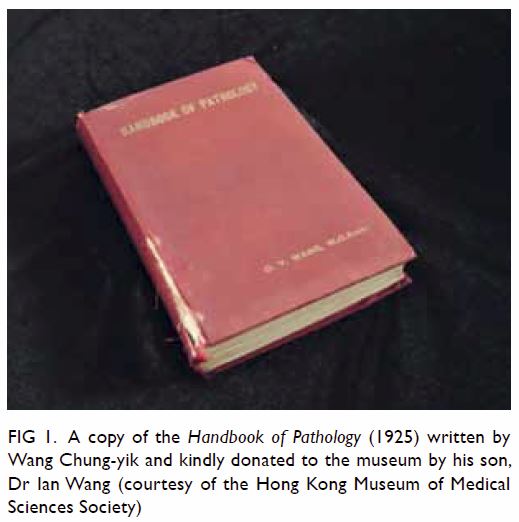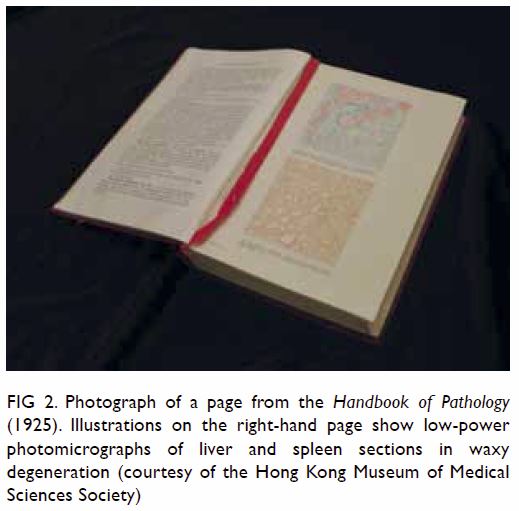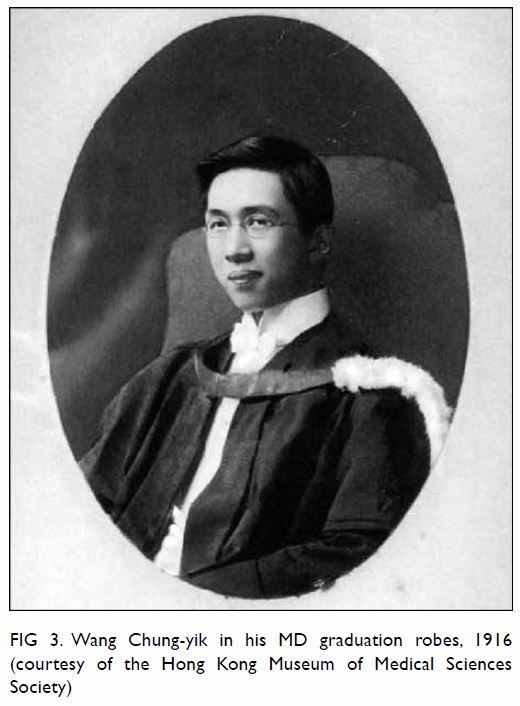© Hong Kong Academy of Medicine. CC BY-NC-ND 4.0
REMINISCENCE: ARTEFACTS FROM THE HONG KONG MUSEUM OF
MEDICAL SCIENCES
Handbook of Pathology
US Khoo, FRCPath, FHKAM (Pathology)
Guest Contributor, Education & Research
Committee, Hong Kong Museum of Medical Sciences Society
The Handbook of Pathology (Fig
1) was written by Professor Wang Chung-yik (1888-1930) during his
tenure as the first and Foundation Chair of Pathology at The University of
Hong Kong, a position he held from 1919 to his death. Wang was the first
ethnic Chinese to hold a full-time chair at the University.1 Published in 1925 as a textbook for students with 282
illustrations, the Handbook is unique not only as the first
Pathology textbook to be written by a Hong Kong author, but also for its
unusual approach.

Figure 1. A copy of the Handbook of Pathology (1925) written by Wang Chung-yik and kindly donated to the museum by his son, Dr Ian Wang (courtesy of the Hong Kong Museum of Medical Sciences Society)
As Wang explained in his preface, the book was
“written with the object of presenting in a short, concise form the more
important and salient points in Pathology, such as appear to the author to
meet the main requirements of the students of medicine for whom this is
primarily intended.”2 Thus, the Handbook
covers only the more common disease conditions of that time, with special
prominence given to morbid anatomy, which the author considered essential
to the understanding and interpretation of functional disorders in
disease. Each entity covered is well illustrated, as far as possible, with
a photograph of a well-preserved gross specimen and/or a photomicrograph
or diagrammatic representation of the condition. These illustrations were
undoubtedly derived from a teaching collection of museum specimens and
microscopic sections which Wang had painstakingly built up with the
establishment of the pathology department at The University of Hong Kong.
Interestingly, throughout the chapters, microscopic
appearance is presented before nakedeye appearance. The diagrammatic
representations presented are actually low-power photomicrographs, mostly
taken at ×46 magnification, with relevant important structures coloured or
highlighted to facilitate easier appreciation of the condition (Fig
2).

Figure 2. Photograph of a page from the Handbook of Pathology (1925). Illustrations on the right-hand page show low-power photomicrographs of liver and spleen sections in waxy degeneration (courtesy of the Hong Kong Museum of Medical Sciences Society)
Unlike conventional textbooks, which are usually
arranged according to organ systems, or by the commonly described
pathological processes, the Handbook is divided into chapters
based on aetiological lines or characteristic tissue changes, with lesions
of a similar or related nature grouped together for discussion (Fig
3). Wang believed that this aetiological approach emphasising the
causes of tissue or cell change in accordance with his own concepts would
be most helpful for his students.

Figure 3. Wang Chung-yik in his MD graduation robes, 1916 (courtesy of the Hong Kong Museum of Medical Sciences Society)
The early chapters of the Handbook deal
with the following introductory topics in turn: morphology of cells;
reproduction of cells; degeneration and allied changes in cells; oedema;
hyperaemia; thrombosis and embolism; infarction; atrophy; hypertrophy and
hyperplasia; and metaplasia. In each of these chapters, the changes
affecting different organs are detailed in turn. The chapters that follow
deal with functional abnormalities: dilatation; haemorrhage; pigmentation;
fever; shock; and inflammation. These chapters also encompass multiple
organs for each abnormality. In particular, the chapter on inflammation is
of significant length, totalling over 100 pages, dealing with inflammation
in one organ system at a time. The remaining chapters cover: acute
infective diseases; diseases due to known bacteria or parasitesa–a long
chapter with significant coverage of syphilis and tuberculosis; disease
due to filter passers; disorders of internal secretion; diseases due to
metabolic disturbances; diseases affecting the blood and blood-forming
organs, and related conditions; and finally tumours–another chapter that
takes up more than one fifth of the book.
Wang’s appointment in 1919 with his subsequent
return to Hong Kong in 1920, marks the start of the department of
pathology which he built from scratch, in a new building on the main
university campus. Wang was a graduate of the Hong Kong College of
Medicine, which was the only tertiary-level educational institute in Hong
Kong at that time.3 The Licentiate
awarded by the College to graduates at that time was not recognised by the
General Medical Council of the United Kingdom; therefore, Wang enrolled at
the University of Edinburgh, obtaining his MB ChB degree in 1910, after
only 2 years of study.1 Motivated
by a desire to learn more about scientific and technological advances in
the major centres of medical education in the West, Wang then undertook a
period of intensive training, obtaining the Edinburgh Diploma of Tropical
Health and Hygiene in 1911, the Diploma of Public Health at Manchester in
1912, and the BSc in Bacteriology and Comparative Pathology in 1913, also
in Manchester.1 He then worked in
the laboratory of the Royal College of Physicians of Edinburgh as an
independent researcher from 1913 to 1919.4
His particular interest was in the field of tuberculosis, which was the
basis of his MD thesis “A study in some phases of tuberculosis, with
special reference to the incidence of bovine infection and the question of
latency and prevalence of the disease,” for which he was awarded a gold
medal from the University of Edinburgh in 19161
(Fig 3). Indeed, tuberculosis research was his
life-long interest.
When the superintendent of the Royal College of
Physicians of Edinburgh laboratory was called up for military service
during the First World War, Wang was appointed Interim Assistant
Superintendent, assuming the responsibility for the general running of the
laboratory and the reporting of many type of specimens submitted for
clinical diagnosis. This included handling specimens from the influenza
pandemic of 1918 and diagnostic work in venereal diseases.
As well as head of the Pathology Department at the
University of Hong Kong, Wang was an Honorary Consultant in Pathology to
the Hong Kong Government and also acting Government Bacteriologist from
1921 to 1922. During this period, Wang was also in charge of the
Government Bacteriological Institute (the building which now houses the
Museum) and the Government Mortuary which served the whole of Hong Kong
Island. Wang also had the responsibility to report on specimens from
university clinics and wards in the Government Civil Hospital, conduct
post-mortem examinations, supervise the production of cowpox, typhoid,
rabies, and autogenous vaccines, and survey various infectious diseases.5
Despite these heavy clinical duties, Wang dedicated
himself to his teaching responsibilities in equally serious fashion.
Tragically, Wang contracted tuberculosis at the height of his career.6 When he could no longer speak on account of
tuberculosis affecting his larynx, he wrote down his lectures and asked an
assistant to read it out of him.6
With little time left for research, his interest in tuberculosis and
laboratory medicine nevertheless continued, with publication of a series
of papers in the Lancet on different aspects of laboratory testing.7 8 9 He passed away at the young age of 42.6 He was remembered as a kind and conscientious teacher
interested in the welfare of his students (personal communication, Dr
Chiu-kwong Yu; 1998). As summed up in his obituary, “There is no doubt
that had his life been spared he would have made his department in the
Hong Kong University a distinguished centre of teaching and research”.10
A copy of the Handbook of Pathology that
was kindly donated by the author’s son, Dr Ian Wang, is on display in the
Old Laboratory at the Hong Kong Museum of Medical Sciences, in the
permanent exhibit entitled ‘Three Notable Pathologists’. The Foundation
stone of the School of Pathology and the School of Tropical Medicine,
dated 1918, served as another reminder of his legacy. The stone was a
prominent landmark at the entrance of the University Pathology Building in
Queen Mary Hospital until the building was decommissioned in 2018.
References
1. Ho FC. Hong Kong’s first Professor of
Pathology and the laboratory of the Royal College of Physicians of
Edinburgh. J R Coll Physicians Edinb 2011;41:67-72. Crossref
2. Wang CY. Handbook of Pathology. London:
John Bale, Sons & Danielsson; 1925.
3. Fu L. From surgeon-apothecary to
statesman: Sun Yat-sen at the Hong Kong College of Medicine. J R Coll
Physicians Edinb 2009;39:166-72.
4. RCPE Archives. Monthly reports of
Superintendent, RCPE Laboratory, 1913-28.
5. Ho FC. The silent protector, a short
centennial history of Hong Kong’s Bacteriological Institute. Hong Kong:
Hong Kong Museum of Medical Sciences Society; 2006: 32-56.
6. Anon. Obituary: Chung Yik Wang. Caduceus
1931;10:1-2.
7. Wang CY. A precipitation test for
syphilis. Lancet 1922;199:274-6. Crossref
8. Wang CY, Basto RA. Further study of a
precipitation test for syphilis. Lancet 1923;201:1262-3. Crossref
9. Wang CY. A new culture medium. Lancet
1928;212:466-7. Crossref
10. Anon. Obituary: Chung Yik Wang
1888-1930. J Pathol Bacteriol 1931;34:189.

